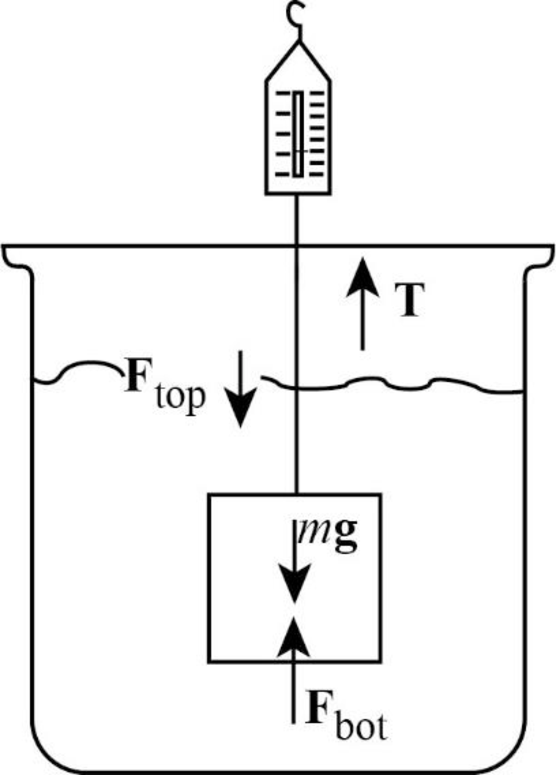
Concept explainers
A 10.0-kg block of metal measuring 12.0 cm by 10.0 cm by 10.0 cm is suspended from a scale and immersed in water as shown in Figure P15.24b. The 12.0-cm dimension is vertical, and the top of the block is 5.00 cm below the surface of the water. (a) What are the magnitudes of the forces acting on the top and on the bottom of the block due to the surrounding water? (b) What is the reading of the spring scale? (c) Show that the buoyant force equals the difference between the forces at the top and bottom of the block.

(a)
The magnitudes of the forces acting on the top and on the bottom of the block due to the surrounding water.
Answer to Problem 25P
The magnitude of the force acting on the top of the block due to the surrounding water is
Explanation of Solution
Write the equation for the pressure at a depth.
Here,
Write the equation for pressure.
Here,
Rewrite the above equation for
Use equation (II) to write the expression for the force at the top of the block.
Here,
Use equation (II) to write the expression for the force on the bottom of the block.
Here,
Conclusion:
The value of
Substitute
Since the vertical dimension of the block is
Substitute
Substitute
Substitute
Therefore, the magnitude of the force acting on the top of the block due to the surrounding water is
(b)
The reading of the spring scale.
Answer to Problem 25P
The reading of the spring scale is
Explanation of Solution
The free-body diagram of the system is shown below.

The tension in the string is the spring scale reading.
The tension in the string is balanced by the vector sum of the weight of the block and the buoyant force.
Write the equation for the tension in the string.
Here,
Write the equation for the weight of the block.
Here,
Write the equation for the buoyant force.
Here,
Put equations (VI) and (VII) in equation (V).
Conclusion:
Substitute
Therefore, the reading of the spring scale is
(c)
To show that the buoyant force equals the difference between the forces at the top and bottom of the block.
Answer to Problem 25P
It is showed that the buoyant force equals the difference between the forces at the top and bottom of the block.
Explanation of Solution
Write the equation for the difference between the forces at the top and bottom of the block.
Here,
Conclusion:
Substitute
Substitute
The value of the difference between the forces at the top and bottom of the block and the magnitude of the buoyant force are equal.
Thus, it is showed that the buoyant force equals the difference between the forces at the top and bottom of the block.
Want to see more full solutions like this?
Chapter 15 Solutions
Bundle: Principles of Physics: A Calculus-Based Text, 5th + WebAssign Printed Access Card for Serway/Jewett's Principles of Physics: A Calculus-Based Text, 5th Edition, Multi-Term
Additional Science Textbook Solutions
Chemistry & Chemical Reactivity
Fundamentals of Physics Extended
Genetics: Analysis and Principles
Laboratory Manual For Human Anatomy & Physiology
Brock Biology of Microorganisms (15th Edition)
Chemistry: The Central Science (14th Edition)
- Under what circumstances is it bad to describe kinetic energy as k = 1/2mv^2arrow_forwardNo chatgpt pls will upvotearrow_forwardAir temperature of 37 °C increases swimming pool temperature of 2.55 °C. What is the fraction of the water in the pool must evaporate during this time to carry enough energy to keep the temperature of the pool constant? 4186 J/(kg°C) = specific heat of water 2,430,000 (2.43 x 106) J/kg = latent heat of vaporization for the water in the pool.arrow_forward
- The iceberg requires 7.4 x 1020 Joules of energy to melt it completely. It absorbs energy from the Sun at a constant average rate of 88 Watts/m2. The total surface area of iceberg exposed to the sunlight is 12 billion (1.2 x 1010) square meters. How long will it take for sunlight to melt the entire iceberg in yearsarrow_forward1.0 kg block of ice to melt in the kitchen. The temperature in the kitchen is 31 °C. The ice starts out at 0 °C and takes an hour to melt and reach the same temperature as the surrounding room (31 °C). How much heat does the 1.0 kg of ice/water absorb from the room as it melts and heats up to 31 °C in Joules absorbed? Latent heat of fusion for water/ice is 334,000 J/kg Specific heat of water is 4186 J/kg°Carrow_forward5.84 If the coefficient of static friction between a table and a uni- form, massive rope is μ, what fraction of the rope can hang over the edge of the table without the rope sliding? 5.97 Block A, with weight Figure P5.97 3w, slides down an inclined plane S of slope angle 36.9° at a constant speed while plank B, with weight w, rests on top of A. The plank is attached by a cord to the wall (Fig. P5.97). (a) Draw a diagram of all the forces acting on block A. (b) If the coefficient of kinetic friction is the same between A and B and between S and A, determine its value. 36.9° 1arrow_forward
 Principles of Physics: A Calculus-Based TextPhysicsISBN:9781133104261Author:Raymond A. Serway, John W. JewettPublisher:Cengage Learning
Principles of Physics: A Calculus-Based TextPhysicsISBN:9781133104261Author:Raymond A. Serway, John W. JewettPublisher:Cengage Learning Physics for Scientists and Engineers with Modern ...PhysicsISBN:9781337553292Author:Raymond A. Serway, John W. JewettPublisher:Cengage Learning
Physics for Scientists and Engineers with Modern ...PhysicsISBN:9781337553292Author:Raymond A. Serway, John W. JewettPublisher:Cengage Learning Physics for Scientists and Engineers: Foundations...PhysicsISBN:9781133939146Author:Katz, Debora M.Publisher:Cengage Learning
Physics for Scientists and Engineers: Foundations...PhysicsISBN:9781133939146Author:Katz, Debora M.Publisher:Cengage Learning Physics for Scientists and EngineersPhysicsISBN:9781337553278Author:Raymond A. Serway, John W. JewettPublisher:Cengage Learning
Physics for Scientists and EngineersPhysicsISBN:9781337553278Author:Raymond A. Serway, John W. JewettPublisher:Cengage Learning College PhysicsPhysicsISBN:9781285737027Author:Raymond A. Serway, Chris VuillePublisher:Cengage Learning
College PhysicsPhysicsISBN:9781285737027Author:Raymond A. Serway, Chris VuillePublisher:Cengage Learning College PhysicsPhysicsISBN:9781938168000Author:Paul Peter Urone, Roger HinrichsPublisher:OpenStax College
College PhysicsPhysicsISBN:9781938168000Author:Paul Peter Urone, Roger HinrichsPublisher:OpenStax College





